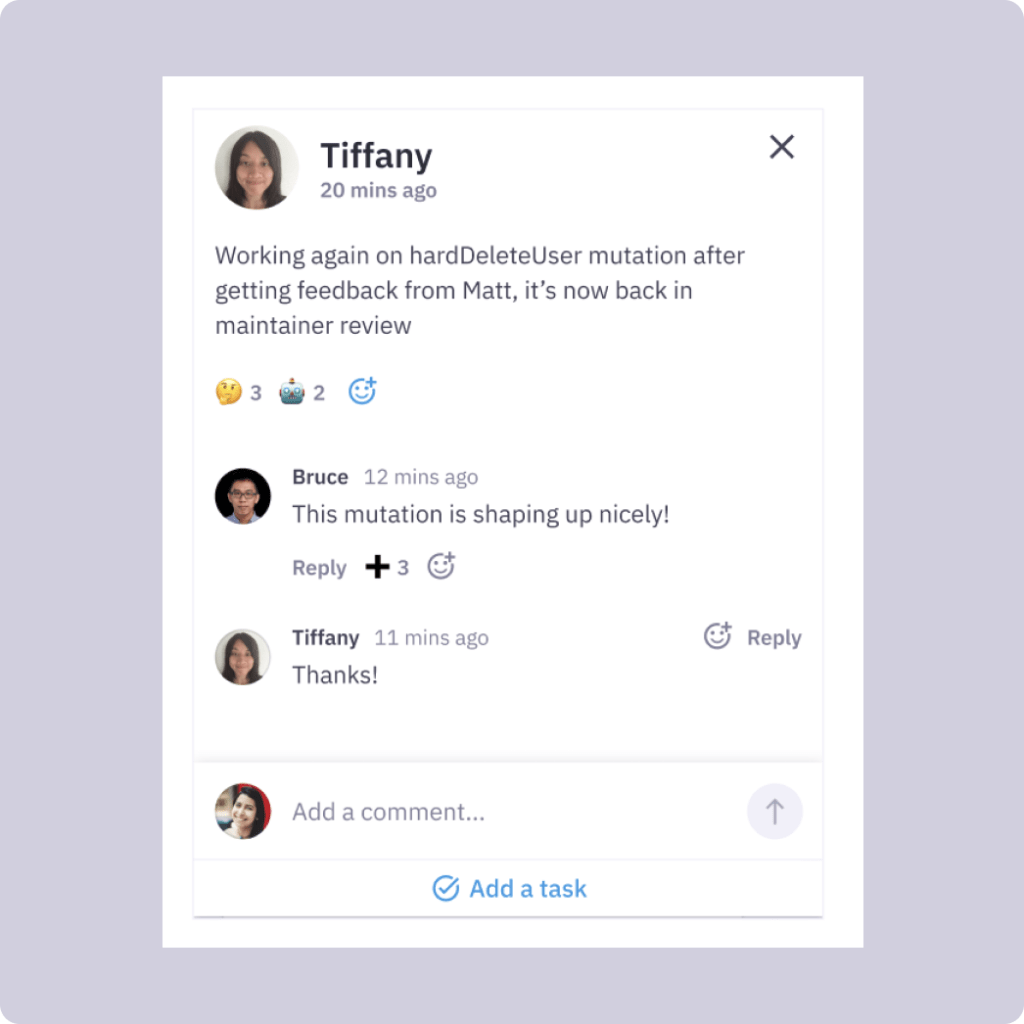14 Daily Standup Formats to Try With Your Team

Today, 87% of Scrum teams hold a daily standup meeting and many other agile and non-agile teams do too. But despite it being the most popular agile meeting in one sense, it’s the most unpopular in another. Many developers complain their standups are boring, pointless, or even a waste of time – especially when the meeting is simply a status update.
A fresh daily standup format can be the difference between a meeting people dread, and one people enjoy. So we’ve dug deep and collected our 14 best ideas to bring your daily standups back to life with some new standup formats.
Here’s a handy list of the 14 daily standup formats we’ve shortlisted so you can jump right to the one that tickles your fancy:
A Quick Refresher on Daily Standups
Scrum and other agile teams hold a 15-minute daily standup every day of a Sprint. People practicing Scrum refer to standups as the “Daily Scrum meeting”. But you may also hear it being called the “daily huddle,” “standup,” or simply “the daily.”
The term “standup” comes from the idea that when everyone is standing, the meeting will be short and sweet.
The daily standup is a chance for teams to check in and unblock one another at the start of the day. For Scrum teams, the event helps inspect progress towards the Sprint Goal and reduces the need for other ad-hoc meetings during the work-day that could break focus.
Philip A. Laplante“It’s amazing how many pointless meetings during the day can be dispensed with by simply standing up together for 10 minutes each day.”
People commonly complain that daily standups are a tool of micromanagement. In reality, teams should use daily standups to set their direction for the day and unblock one another, rather than give status updates and try to prove to the boss they are working.
👩🏾🎓 Check out our Daily Scrum: Complete Beginner’s Guide for more details on the basics of the daily standup.
14 daily standup formats to revive your meetings
We’ve shortlisted our favorite daily standup formats that you can experiment with. Try something new from time to time, or use one of these formats for example on a Friday or Monday to start or end the week differently.
1. Scrum’s standard standup questions
Previous versions of the Scrum Guide recommended a daily standup agenda with three questions to ask during the meeting:
- What did you do yesterday?
- What will you do today?
- Are any blockers or impediments preventing you from doing your work?
Teams typically go around a circle answering the three questions above, one person at a time.
The Scrum Guide no longer prescribes these questions, but they’re a good starting point for teams new to Scrum and agile. Experienced teams usually find their daily standups more effective – and enjoyable! – when they move on from these prompts.
⚠️ A word of caution! It’s easy for this format to turn into a dreaded status update. This may not be a good use of your time, so try to focus specifically on helping unblock each other instead of talking about how much you achieved yesterday.
2. The built-in prep format
Lyssa Adkins in Coaching Agile Teams“On time is already late… What would the stand-up be like if the team members were on time with more than their bodies? If they arrived on time, mind and body, and ready for the day’s work ahead, what would be the difference in their conversations?”
Before abandoning Scrum’s three questions immediately and completely, see if adding some preparation time to your daily standup improves it.
Play a gong or song – Bob Marley’s “Get Up Stand Up” – shortly before the formal start of the meeting. That gives people time to update the task board or consider what they want to share during the standup.
At NerdCow, Product Manager Dawid Zimny and his team have a dedicated Kanban board in Jira for their standup. Everyone adds tasks there for inspection during the meeting. This practice prevents people from worrying about which items to talk about once the standup is underway.
3. The “Blockers First” standup
To run a blockers first standup, you can ask via a show of hands “who is blocked on something right now”, and focus on discussing those blocked issues first.
Tackling your team’s roadblocks and bottlenecks first makes sure the most important issues are discussed before the meeting ends.
If you are using an online kanban board with a “stuck” or “blocked” column, you can even use these blocked items as your rough agenda. The goal is then to interrogate what’s stuck, why it’s stuck, and how to resolve the issue.
This daily standup format helps you prevent your dailies turning into status meetings.
You can even divide your 15-minute standup timebox by the number of stuck issues so you stay on time.
4. Asynchronous standups
Teams can try running their standups asynchronously using Slack, email, or Parabol’s online standup tool.

Async standups have several benefits:
- 🌙 Nobody has to join the meeting at odd hours.
- 🕦️ Each team member can contribute at a time that best suits their life, workflow, and energy rhythm.
- 🤗 Input is more inclusive since introverts don’t have to fear speaking in front of a group or being put on the spot by peers.
- 🔍️ Information becomes searchable and linkable since everything is written down instead of spoken.
In a synchronous standup, everyone will hear everyone else’s input. With async standups it’s the responsibility of your team members to read each others’ updates.
Some teams address these problems by adding a short video or quick video call to the written update. These approaches can work but add more reporting burden on the team.
Parabol’s async standup tool solves this issue by displaying everyone’s update in one grid view instead of a list, so it’s hard to miss what others are sharing. Changing your daily standup’s question is also straightforward, so you can break through the imagined reality of unchangeable standup prompts with just a click.
💡 Learn more about the benefits and pitfalls of async standups in Virtual vs Async Standups: Which is Right For Your Team?
5. Walking the Board
When using the Walk the Board daily standup format, the Sprint or Kanban board items drive the meeting agenda, not the attendees or a set of questions. Walking the board focuses more on the team and its work than on individuals, which is why some people rave about this approach to standups.
This approach focuses on asking, “what can we finish today?” You start from the right side of the board with the items that are closest to reaching the Done column and discuss what stands in the way of getting them done today.
You then work your way left until you reach items that the team has just started.
The benefit of Walk the Board is that it’s less ego-driven. People don’t feel obligated to give needless status updates to prove they are working. Instead, the team are collaborating to keep work items flowing by reducing Work In Progress (WIP).
6. Daily wrap-ups
Matt Galligan, co-founder and CEO of web3 startup XMTP, recommends a daily wrap-up instead of standup. You do it at the end of the day, so your work is still fresh in your mind.
He proposes a different set of questions for the wrap-up, too:
- What’s worth sharing?
- What needs feedback?
- Who do you need help from?
These open questions prevent useless answers that Scrum’s daily standup questions “what did you do today?” might evoke (“same as yesterday”). They’re also broad and optional, inviting variety and surprise (“I got engaged!”), while reducing the need for forced responses or blame games triggered by “are there any blockers?”
Finally, they encourage people to focus only on what others need to know rather than reporting every single task they did.
Parabol runs a version of the daily wrap-up on a weekly basis. We call it the Friday Ship and write a public blog about what we achieved for investors and people in our hiring pipeline.
7. The “User Stories First” approach
In Scrum’s traditional daily scrum format, the developers drive the meeting and do the talking. But since agile is all about customer value, why not put the customer in the center by discussing the Sprint’s user stories?
Instead of going around the circle of meeting attendees, talk through the Sprint Backlog items on the task board in order of importance or completion status. Let the people working on each item comment on any work planned on those items or impediments. This approach means one person might speak several times during a meeting instead of just once, and that’s okay.
This focus on the user stories keeps the standup anchored by the work and its progress, not individual contributions and status updates.
🤷🏽♀️ Isn’t this approach the same as number five, Walking the Board?
Walk the Board focuses on the question “What can we finish today?” and assumes you have a board with work items to discuss.When you focus on user stories, you could just be looking at a list of items like the Sprint Backlog.
You can also prioritize according to different criteria. Instead of asking, “how close are items to being finished?” you could review them by size, effort, or expected impact on achieving the Sprint Goal. Experienced agile teams can also opt for only talking about blocked user stories.
8. Weekly standup meetings or weekly wrap-ups
Holding standups every day at the same time and place turns the event into a habit that doesn’t need much planning or thought. Try doing a weekly wrap-up instead if you all have transparency over sprint goal progress in your Scrum/Kanban board.
But if the daily cadence doesn’t work for your team, why not change it to a lower frequency, like weekly?
One common complaint about daily standups – especially for distributed teams – is that they break your flow once per day. People work best at different times. One team member’s ideal daily standup time might be another’s most productive hour.
Taft and his team at Iceberg RevOps run a weekly all-team standup, complemented with 1:1s or small group meetings throughout the week.
Their weekly standup lasts one hour, and its format changes each week. Often, it includes a training session or discussion followed by updates from each team member.
9. The Traffic Lights standup
The Traffic Lights approach uses the classic green amber red colors to check how team-mates feel about their work. The goal of a daily standup is not only to inspect progress and unblock one another. It’s also a chance to check in emotionally with one another.
Ask your colleagues how they feel about their work today. Are they green, amber, or red?
Focus first on discussing people who said they are “red”. Perhaps they’re simply blocked, or maybe they’re struggling with something, or feeling frustrated or upset. Resolving emotional tension also contributes to helping your team achieve their goals. This standup format bakes in an opportunity to have those deeper conversations.
10. The daily sit-down
A close second on the list of imaginary daily standup rules is the standing-up part. Some teams faithfully stand because that supposedly keeps the meeting short. Some even plank! 😳 Why not try sitting down instead for a calmer standup.
For one, standing is no guarantee of the 15-minute timebox. But it might also have other side effects. Agile coach Angela Druckman found that getting people out of standing in conference rooms and sitting in a comfortable environment relaxed their body posture and eased their communications. That change made daily standups a relaxed affair instead of a formal, unpleasant event.
11. Needs-based standups
Trigger your standup when you have enough blockers to necessitate one. This format blows apart the assumption that the clock and calendar dictate when a meeting happens.
Jeet Mehta and his team at Swift keep a pinned post at the top of a dedicated Slack channel. Whenever a team member has a talking item, they add it asynchronously to this message thread. When this list hits five points, the person adding the fifth item schedules a standup.
The process starts over with a new pinned post when the meeting finishes. This approach ensures the team only meets when necessary. It’s also efficient because they have a ready-made agenda based on the five items in the Slack thread.
12. Tactical Meetings from Holacracy
Agile ways of working have a lot in common with Holacracy – a method of decentralized management first conceptualized in the 1950s and expanded on much later by Brian Robertson. One of the specific meetings outlined in Holacracy is called a “tactical meeting”. It works great as a standup alternative.

Tactical meetings serve many of the same goals as a daily standup and could be something to try if your regular standup process is no longer delivering the goods. According to the Holacracy guide, the purpose of a tactical meeting – like a daily standup – is:
“To triage issues that have come up recently and remove obstacles so that the work can move forward.”
In a tactical meeting, teams gather usually once per week rather than daily. The meeting runs through a set of phrases:
- ☕ Check-in round. Team members get present for the meeting by answering an icebreaker question or calling out any distractions.
- ✅ Checklist review. Team members check whether recurring actions have been completed (if they exist).
- 📈Metrics review. A member of the team updates everyone on key metrics for the week.
- 💬 Project updates. Each person gives an update on how their project efforts (or progress towards a Sprint Goal) is going.
- 🤔 Triage issues. This is the main part of the meeting where team members unblock each other or ask for clarifications. The facilitator typically asks “what do you need” on each triage issue, and when the item has been discussed, asks “did you get what you need” to close the agenda item.
Parabol’s check-in meeting activity helps teams run a tactical meeting by guiding them through the different phases automatically.
13. The Lean Coffee format
You might have tried a Lean Coffee meeting before. But probably not for a standup. Lean Coffees are agenda-less meetings where team members anonymously vote on topics they want to discuss.

It makes a good format for daily standups because it means your regular meetings focus on real issues rather than simply status updates.
The facilitator simply asks “what’s on your mind?” or “what should we talk about?” and takes it from there.
You can run a Lean Coffee meeting directly via Parabol’s free retrospective tool.
14. The “Wins and Blockers” standup
With the Wins and Blockers format you focus on the two most important things:
- Wins you had as a team or important progress updates
- Blockers that are preventing team members from moving to the end goal
Daily standups are a chance to come together as a team and motivate one another for the day ahead. Why wait until your retrospective or the end of your project to celebrate wins in your team?
Sometimes when you’re mid-sprint or part-way through a project, motivation can dwindle. But celebrating some wins every day creates a positive environment where everyone can see the forward motion.
You can run this standup exercise by asking people to asynchronously write their Wins and Blockers in a standup tool like Parabol. Or simply dividing the meeting with two questions:
- “Who has a win they want to share?”
- “Who has a blocker they need resolved?”
You can write these two questions up on a whiteboard in columns and ask people to quickly jot down their win or blocker before talking through them as a whole team.
Which daily standup format should I start with?
Beginner Scrum teams would do well to stick to number one on the list above for a while – Scrum’s three standard standup questions. More mature groups report that the value of their daily standups fizzles when sticking to that same fill-in-the-blanks exercise day after day.
Taft Love, Founder Iceberg RevOps“Any format that requires people to fill in the blanks has the potential to get boring… Keeping people engaged when it’s easy to just go through the motions of the standup is difficult.”
Your daily standups are yours to shape as you wish. So don’t be afraid to break from the norms and try something different. You might just find that your team members appreciate a new and creative approach once in a while!
Make life easier with an online standup tool
You can do your standups manually on Zoom, Slack, or in front of a board. But Parabol’s online standup tool can make your life much easier, so why not try it out?
We’ve tried every imaginable approach and tool for async standups ourselves but found that most:
- Disrupt your team’s flow of work.
- Involve sitting through long updates.
- Compromise those in different time zones.
- Get off track or run over time.
That’s why we’ve developed our own online standup solution. It saves your team time while staying up-to-date. You can share updates on your own time, set a cadence that suits your team, and review updates when you’re ready.

Break free from formats and focus on the Sprint Goal
If none of these daily standup formats and templates work for you, consider dedicating a retrospective to brainstorming what can be improved. Revisit the essence of the meeting, ideally together with a Scrum Master or Agile Coach.
Even though the legacy of the Scrum Guide imprisons many agile teams in a standup format that doesn’t exist anymore, the latest version isn’t a bad starting point for such a retro. It states the goal of the daily standup meeting and allows you to achieve it the way you want:
The Scrum Guide“The purpose of the Daily Scrum is to inspect progress toward the Sprint Goal and adapt the Sprint Backlog as necessary, adjusting the upcoming planned work… The Developers can select whatever structure and techniques they want, as long as their Daily Scrum focuses on progress toward the Sprint Goal and produces an actionable plan for the next day of work.”
The Scrum Guide gives you free rein to find your own daily standup format.
So what are you waiting for?
💡 Check out our Daily standup hub for an overview of all our resources on daily standups.






